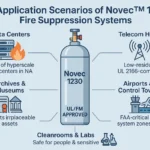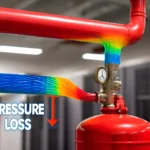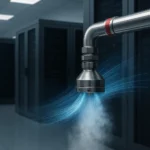With the rapid rise of AI workloads and high-density computing, data centers are expanding faster than ever. These facilities often operate at power densities above 15 kW per rack, significantly increasing heat output and fire risk. While cybersecurity and access control remain top priorities, a server room fire remains one of the most immediate and devastating threats.
According to the National Fire Protection Association (NFPA), electrical failures cause nearly 30% of electrical fires in server rooms and data centers. The Uptime Institute reports that the average outage cost has surged to $740,000 per incident. Implementing a clean agent fire suppression system, compliant with NFPA 75, is critical to extinguish fires quickly, protect critical assets, and ensure business continuity without damaging sensitive electronic equipment.
Fire Risks in Server Rooms

Data centers and server rooms face multiple critical fire risks driven by the complexity and density of modern IT infrastructure. One of the primary causes is electrical fires, often triggered by overloaded circuits, faulty power supplies, and aging electrical components. High-density equipment racks operating continuously at elevated power levels further increase the risk of overheating.
Another significant hazard is cooling system failure. Ineffective or poorly maintained HVAC systems can lead to rising temperatures, while accumulated dust within cooling units and under raised floors may act as fuel or create conditions for electrostatic discharge (ESD)—a well-known ignition source for sensitive electronics.
Additional risks include improper cable management, which restricts airflow and causes localized heat buildup, and the presence of flammable materials such as plastic cable insulation and packaging materials. Energy storage solutions, including large-scale lithium-ion battery backup systems (UPS), introduce the risk of thermal runaway, a highly dangerous condition that can lead to uncontrollable server room fires.
Furthermore, poor airflow containment—such as failure of hot and cold aisle configurations—can create unexpected heat zones, further elevating fire risk. Human error, including inadequate equipment maintenance and unauthorized system modifications, remains a common contributing factor in server room fire incidents.
Fire Suppression Systems for Server Rooms

When protecting critical assets in server rooms and data centers, selecting the right fire suppression system for server rooms is essential. Traditional methods like water-based sprinkler systems or dry chemical agents are unsuitable because they can cause severe damage to sensitive electronic equipment and leave harmful residues.
Clean agent fire suppression systems are specifically engineered for environments housing high-value electronics. These systems quickly extinguish fires without damaging sensitive electronic equipment or leaving any residue, ensuring minimal downtime and no costly cleanup. They work by either reducing oxygen concentration to below combustion thresholds or absorbing heat to interrupt the fire triangle, all while remaining safe for occupied spaces.
Common Types of Clean Agent Systems
FM-200 (Heptafluoropropane)
FM-200 (Heptafluoropropane) is widely adopted for its rapid fire suppression capabilities and safety for occupied areas. It leaves no residue and is fully compliant with both NFPA 75 and NFPA 2001 standards, making it a reliable choice for protecting critical IT infrastructure. However, its higher environmental impact, due to some ozone-depleting potential, and relatively high refill and maintenance costs may be a concern for organizations focused on sustainability and long-term operating expenses.
Novec 1230 (FK-5-1-12)
Novec 1230 (FK-5-1-12) is known for its exceptional environmental performance, featuring zero ozone-depleting potential and rapid fire suppression effectiveness. It is safe for sensitive electronic equipment and approved under the EPA SNAP program, making it an ideal choice for data centers prioritizing environmental responsibility. Although the initial installation cost is higher than other agents, its low environmental risk and reduced long-term liability contribute to a favorable Total Cost of Ownership (TCO) for forward-looking organizations.
Inert gas systems
Inert gas systems, such as IG-541 and IG-55, utilize naturally occurring gases like nitrogen and argon to suppress fires without any environmental impact. These systems are safe for electronic equipment and offer long-term stability of the suppression agent, which minimizes ongoing maintenance costs. However, they require larger storage space for gas cylinders and typically involve higher upfront installation expenses. Additionally, suppression times are generally slower compared to chemical agents, which may be a consideration in environments requiring immediate fire suppression.
Note: All clean agent systems require a room integrity test to ensure proper agent concentration is maintained during discharge, a critical compliance requirement under NFPA 2001.
Why Avoid Dry Chemical and Water-Based Systems?
Dry chemical agents, while effective for industrial fires, can severely damage sensitive IT infrastructure by leaving corrosive powders that are difficult to clean and may cause long-term equipment failures.
Water-based sprinkler systems pose a direct risk of short-circuiting and physical damage to electronic hardware. Even minimal water exposure can render critical systems inoperable, leading to significant downtime and irrecoverable data loss.
For these reasons, clean agent fire suppression systems remain the most reliable, regulation-compliant, and business-friendly solution for protecting modern server rooms and data centers.
Regulatory Standards and Policies
In the U.S., NFPA 75 and NFPA 2001 are the primary enforceable standards for fire protection in server rooms and data centers, covering detection, suppression, and system integrity requirements. These are often mandated by state codes, especially in California and New York. The IBC and IFC further require automatic suppression systems in critical facilities, while OSHA enforces workplace fire safety standards.
Beyond mandatory regulations, organizations rely on FM Global’s FM 5-32 for risk reduction and insurance considerations, and the Uptime Institute Tier Standards to support resilient infrastructure planning. The EPA SNAP Program guides the selection of environmentally safe suppression agents.
Using UL Listed and FM Approved systems ensures compliance, supports insurance claims, and strengthens risk management.
In today’s data-driven world, protecting server rooms and data centers from fire risks is critical to ensuring business continuity and safeguarding valuable digital assets. Selecting the right clean agent fire suppression system and complying with industry standards like NFPA 75 and NFPA 2001 are essential steps toward that goal.
Flarenix specializes in delivering advanced, certified fire protection solutions tailored for critical IT environments. Contact us today to explore how we can help secure your infrastructure with reliable, compliant, and environmentally responsible systems.




